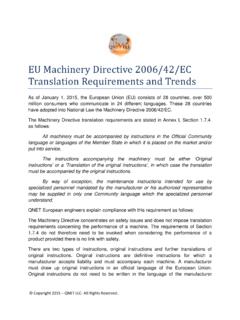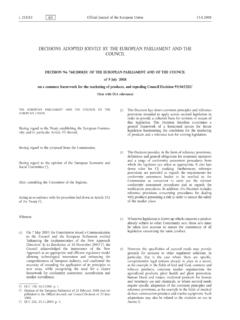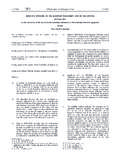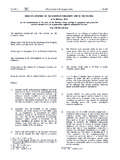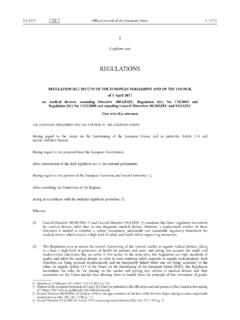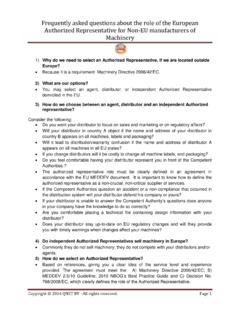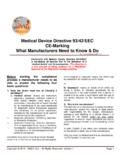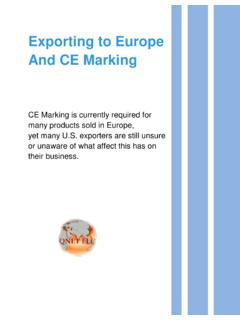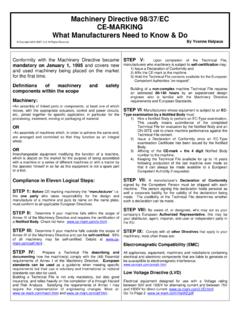Transcription of L 117/176 EN Official Jour nal of the European Union
1 REGULATION (EU) 2017/746 OF THE European PARLIAMENT AND OF THE COUNCIL of 5 April 2017 on in vitro diagnostic medical devices and repealing Directive 98/79/EC and Commission Decision 2010/227/EU (Text with EEA relevance) THE European PARLIAMENT AND THE COUNCIL OF THE European Union , Having regard to the Treaty on the Functioning of the European Union , and in particular Article 114 and Article 168(4)(c) thereof, Having regard to the proposal from the European Commission, After transmission of the draft legislative act to the national parliaments, Having regard to the opinion of the European Economic and Social Committee (1), After consulting the Committee of the Regions, Acting in accordance with the ordinary legislative procedure (2), Whereas: (1) Directive 98/79/EC of the European Parliament and of the Council (3) constitutes the Union regulatory framework for in vitro diagnostic medical devices.
2 However, a fundamental revision of that Directive is needed to establish a robust, transparent, predictable and sustainable regulatory framework for in vitro diagnostic medical devices which ensures a high level of safety and health whilst supporting innovation. (2) This Regulation aims to ensure the smooth functioning of the internal market as regards in vitro diagnostic medical devices, taking as a base a high level of protection of health for patients and users, and taking into account the small and medium-sized enterprises that are active in this sector. At the same time, this Regulation sets high standards of quality and safety for in vitro diagnostic medical devices in order to meet common safety concerns as regards such products.
3 Both objectives are being pursued simultaneously and are inseparably linked whilst one not being secondary to the other. As regards Article 114 of the Treaty on the Functioning of the European Union (TFEU), this Regulation harmonises the rules for the placing on the market and putting into service of in vitro diagnostic medical devices and their accessories on the Union market thus allowing them to benefit from the principle of free movement of goods. As regards Article 168(4)(c) TFEU, this Regulation sets high standards of quality and safety for in vitro diagnostic medical devices by ensuring, among other things, that data generated in performance studies are reliable and robust and that the safety of subjects participating in performance studies is protected.
4 (3) This Regulation does not seek to harmonise rules relating to the further making available on the market of in vitro diagnostic medical devices after they have already been put into service, such as in the context of second- hand sales. (4) Key elements of the existing regulatory approach, such as the supervision of notified bodies, risk classification, conformity assessment procedures, performance evaluation and performance studies, vigilance and market surveillance should be significantly reinforced, whilst provisions ensuring transparency and traceability regarding in vitro diagnostic medical devices should be introduced, to improve health and safety.
5 (5) To the extent possible, guidance developed for in vitro diagnostic medical devices at international level, in particular in the context of the Global Harmonization Task Force and its follow-up initiative, the International Medical Devices Regulators Forum, should be taken into account to promote the global convergence of L 117/176 Official Journal of the European Union EN (1) Opinion of 14 February 2013 (OJ C 133, , p. 52). (2) Position of the European Parliament of 2 April 2014 (not yet published in the Official Journal) and position of the Council at first reading of 7 March 2017 (not yet published in the Official Journal).
6 (3) Directive 98/79/EC of the European Parliament and of the Council of 27 October 1998 on in vitro diagnostic medical devices (OJ L 331, , p. 1). regulations which contributes to a high level of safety protection worldwide, and to facilitate trade, in particular in the provisions on Unique Device Identification, general safety and performance requirements, technical documentation, classification rules, conformity assessment procedures and clinical evidence. (6) There are specific features of in vitro diagnostic medical devices, in particular in terms of risk classification, conformity assessment procedures and clinical evidence, and of the in vitro diagnostic medical device sector which require the adoption of specific legislation, distinct from the legislation on other medical devices, whereas the horizontal aspects common to both sectors should be aligned.
7 (7) The scope of application of this Regulation should be clearly delimited from other legislation concerning products, such as medical devices, general laboratory products and products for research use only. (8) It should be the responsibility of the Member States to decide on a case-by-case basis whether or not a product falls within the scope of this Regulation. In order to ensure consistent qualification decisions in that regard across all Member States, particularly with regard to borderline cases, the Commission should be allowed to, on its own initiative or at the duly substantiated request of a Member State, having consulted the Medical Device Coordination Group ( MDCG ), decide on a case-by-case basis whether or not a specific product, category or group of products falls within the scope of this Regulation.
8 When deliberating on the regulatory status of products in borderline cases involving medicinal products, human tissues and cells, biocidal products or food products, the Commission should ensure an appropriate level of consultation of the European Medicines Agency, the European Chemicals Agency and the European Food Safety Authority, as relevant. (9) It appears that it is possible that divergent national rules regarding the provision of information and counselling in relation to genetic testing might only have an impact on the smooth functioning of the internal market to a limited extent.
9 Therefore, it is appropriate to lay down only limited requirements in this regard in this Regulation, having regard to the need to ensure constant respect of the principles of proportionality and subsidiarity. (10) It should be made clear that all tests that provide information on the predisposition to a medical condition or a disease, such as genetic tests, and tests that provide information to predict treatment response or reactions, such as companion diagnostics, are in vitro diagnostic medical devices. (11) Companion diagnostics are essential for defining patients' eligibility for specific treatment with a medicinal product through the quantitative or qualitative determination of specific markers identifying subjects at a higher risk of developing an adverse reaction to the medicinal product in question or identifying patients in the population for whom the therapeutic product has been adequately studied, and found safe and effective.
10 Such biomarker or biomarkers can be present in healthy subjects and/or in patients. (12) Devices that are used with a view to monitoring treatment with a medicinal product in order to ensure that the concentration of relevant substances in the human body is within the therapeutic window are not considered to be companion diagnostics. (13) The requirement to reduce risks as far as possible should be fulfilled taking into account the generally acknowledged state of the art in the field of medicine. (14) Safety aspects addressed by Directive 2014/30/EU of the European Parliament and of the Council (1) are an integral part of the general safety and performance requirements laid down in this Regulation for devices.
